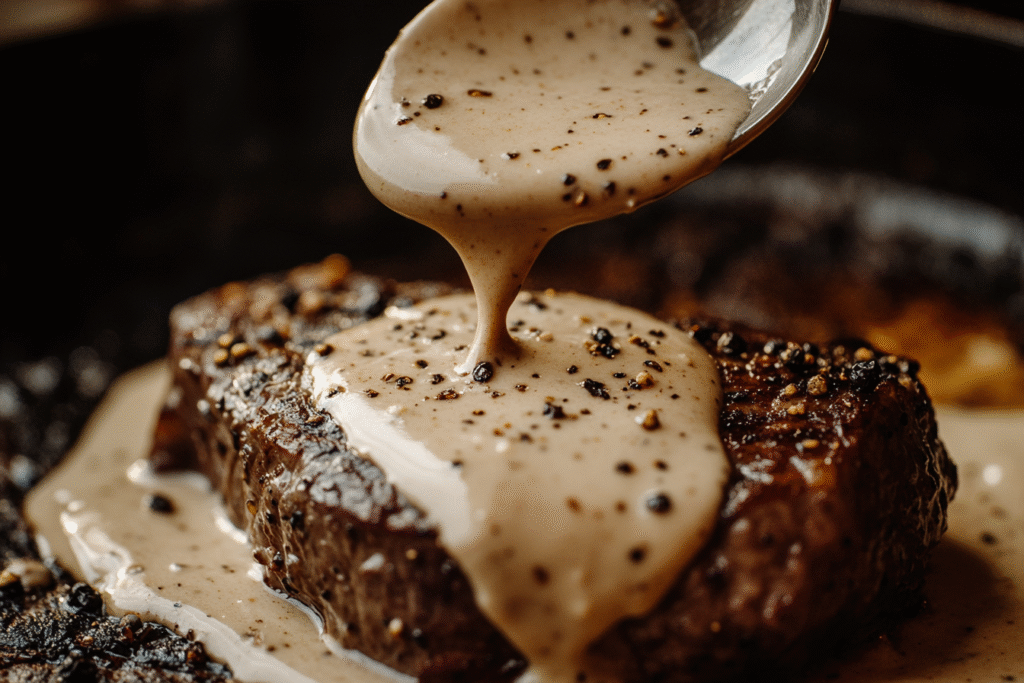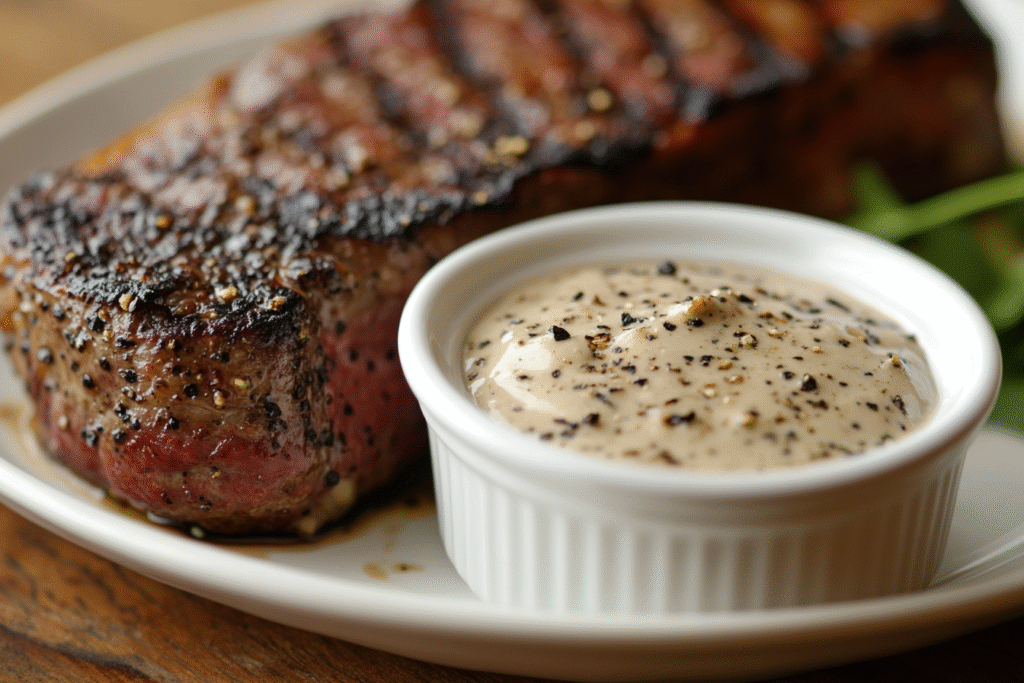Few sauces command as much respect—and salivating anticipation—as a classic creamy peppercorn sauce. Rich, velvety, and punctuated with bursts of fragrant black peppercorns, it’s a staple in fine steakhouses and French bistros alike. But the best part? This luxurious sauce is surprisingly easy to master at home with just a few ingredients and a bit of technique.
In this comprehensive guide, you’ll learn how to make an authentic peppercorn sauce that delivers restaurant-quality flavor, ideal for pouring over steak, grilled chicken, pork chops, or even roasted vegetables. We’ll walk through each element, from choosing the right peppercorns to building flavor with cognac and stock, and ensuring the perfect creamy consistency.
Why This Sauce Is So Iconic (and Irresistible)
The magic of a peppercorn sauce lies in contrast. It’s simultaneously rich and sharp, creamy yet peppery. You get the intense depth of a reduction sauce, smoothed out with cream, and a bold bite from crushed peppercorns that dance across your palate without overwhelming it.
Traditionally served with filet mignon or ribeye, this sauce was born out of French cuisine’s love for butter, pan juices, and cognac. When done right, it feels indulgent, balanced, and worthy of your best steak knife. But don’t limit it to steak—this sauce elevates simple proteins into memorable meals.
Common Mistakes (And How to Fix Them)
Let’s tackle some typical pitfalls before they happen:
- Overheating the cream: Cream can separate or burn if the pan is too hot. Use medium heat and stir often.
- Not deglazing properly: Skipping this step means you’re missing out on the fond—the browned bits that add depth.
- Too much pepper: Yes, this is a peppercorn sauce, but balance matters. Use crushed peppercorns, not powdered black pepper.
- Weak flavor: If your sauce tastes flat, it’s often due to a lack of reduction or under-seasoning.
Patience is your secret weapon here. Let the sauce simmer long enough to concentrate the flavor, and season just before finishing.

Choosing the Right Peppercorns
The star of the show deserves some attention. Here’s a breakdown:
- Black peppercorns: Classic, bold, and aromatic. Crush them coarsely to get that signature texture.
- Green peppercorns (brined or dried): Milder and slightly fruity. Common in French-style sauces and can be used alone or in combo.
- Mixed peppercorns: These blends often include pink and white varieties, adding floral and earthy notes.
For a traditional sauce, go with coarsely crushed black peppercorns. If you want to mellow things out, substitute half with green peppercorns.
👉 How to crush peppercorns: Use a mortar and pestle, or place them in a zip-top bag and gently crack them with a rolling pin or the bottom of a skillet.
Ingredient Breakdown: Quality Over Quantity
This sauce uses fewer than ten ingredients, which makes quality even more important.
- Cognac or brandy: Adds a deep, fruity backbone. It’s also what gives the sauce its signature flavor. You can substitute with bourbon or dry sherry, but cognac is ideal.
- Beef or veal stock: Use a rich, reduced stock for maximum umami. Avoid canned broth if possible—opt for homemade or high-quality concentrated stock.
- Heavy cream: This brings everything together into a smooth, luscious consistency.
- Butter and shallots: Classic French flavor builders.
- Dijon mustard (optional): A tiny dab can add brightness and complexity.
Equipment Tips
You don’t need a gourmet kitchen, but the right tools help:
- Heavy-bottomed skillet or sauté pan: Conducts heat evenly, essential for reducing the sauce without burning it.
- Wooden spoon or silicone spatula: Ideal for scraping up fond and stirring cream without scorching.
- Measuring spoons and cup: Accuracy matters, especially with high-flavor ingredients like alcohol and mustard.

Clever Substitutions and Dietary Tweaks
- No cognac? Try dry white wine or brandy. Bourbon also works but changes the flavor slightly.
- Dairy-free? Use full-fat coconut cream (expect a different flavor profile).
- Vegetarian version? Swap the beef stock for a rich mushroom or onion stock.
Flavor Boosters and Customizations
Want to elevate this sauce even more? Try:
- A splash of Worcestershire sauce for umami depth.
- A few drops of balsamic vinegar for sweetness and acidity.
- A sprig of thyme or rosemary during the reduction step (remove before adding cream).
- A teaspoon of Dijon mustard for brightness and a slight tang.
These additions aren’t required but can help you tailor the sauce to your preferences or the dish it’s accompanying.
Ingredients
Base Ingredients:
- 1 tbsp whole black peppercorns (crushed)
- 1 tbsp unsalted butter
- 1 small shallot, finely minced
- ¼ cup cognac or brandy
- ½ cup beef or veal stock (reduced or high-quality)
- ¾ cup heavy cream
- Salt, to taste
Optional Enhancers:
- 1 tsp Dijon mustard
- 1 tsp Worcestershire sauce
- 1 sprig fresh thyme (removed before serving)
Step-by-Step Instructions
Step 1: Crush the Peppercorns
Using a mortar and pestle or a rolling pin, coarsely crush the peppercorns. You want irregular pieces—not powder—so the texture and flavor come through.
Step 2: Sauté the Shallots
In a heavy skillet, melt the butter over medium heat. Add the minced shallots and sauté for 2–3 minutes, until soft and translucent but not browned.
Step 3: Toast the Peppercorns
Add the crushed peppercorns to the pan and stir for 30 seconds. This blooms their flavor and makes the sauce more fragrant.
Step 4: Deglaze with Cognac
Carefully pour in the cognac. If you’re feeling bold and using a gas stove, you can flambé the cognac to burn off the alcohol—just stand back and ignite with a long lighter. Otherwise, simmer for 1–2 minutes until the alcohol smell dissipates.
Use a wooden spoon to scrape up any brown bits from the bottom of the pan—these add big flavor.
Step 5: Add the Stock and Reduce
Pour in the beef or veal stock and bring to a gentle boil. Let it reduce by half (this takes 3–5 minutes), concentrating the flavor.
Step 6: Stir in Cream
Lower the heat to medium-low. Add the heavy cream and stir gently. Simmer for 4–5 minutes, stirring occasionally, until the sauce thickens enough to coat the back of a spoon.
If using, stir in the Dijon mustard or Worcestershire sauce at this point.
Step 7: Season and Finish
Taste the sauce and season with salt if needed. Remember: the stock may already be salty, so season carefully.
Optional: Strain the sauce through a fine mesh sieve for an ultra-smooth finish, or leave the peppercorns in for texture and visual appeal.
Troubleshooting and Tips
- Sauce won’t thicken? Simmer a few minutes longer. If still too thin, whisk in a teaspoon of cornstarch mixed with cold water.
- Too sharp or peppery? Stir in a bit more cream or a small knob of butter to mellow it out.
- Separated sauce? Remove from heat and whisk vigorously. Adding a splash of cream can help bring it back together.
Serving Ideas
This peppercorn sauce is luxurious on:
- Grilled steak (filet mignon, ribeye, NY strip)
- Pork tenderloin or chops
- Roasted chicken thighs or breast
- Grilled portobello mushrooms (vegetarian option)
- Mashed potatoes or polenta
Serve warm, spooned generously over your main dish. Garnish with a few fresh crushed peppercorns or a sprinkle of parsley if desired.
Storage and Reheating
- To Store: Refrigerate leftovers in an airtight container for up to 4 days.
- To Reheat: Warm gently over low heat, stirring constantly. Add a splash of cream if it thickens too much.
- Not freezer-friendly: Cream sauces tend to separate when frozen and thawed. Best made fresh or stored short-term in the fridge.
Sauce Comparison: Au Poivre vs. Peppercorn Sauce vs. Gravy
- Steak au Poivre: Typically a pan-seared steak crusted in peppercorns with a cognac-cream sauce.
- Peppercorn Sauce: Often smoother and served alongside rather than cooked with the meat.
- Gravy: Usually made from pan drippings and thickened with flour—not cream-based, and pepper isn’t the focus.
Our classic creamy peppercorn sauce is somewhere in the middle: sophisticated like au poivre but versatile and silky enough to use like a sauce or even a creamy drizzle.
Whether you’re making it for steak night or elevating a weeknight dinner, this sauce has the power to transform your plate. It’s one of those recipes every home cook should have in their back pocket—and after one try, you’ll see why.


